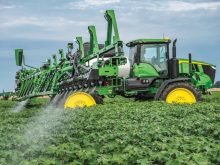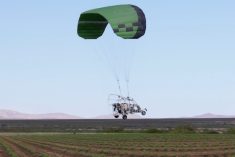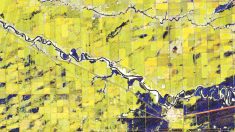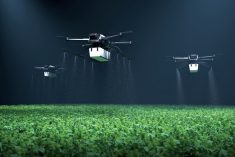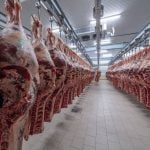While interest in precision agriculture has surged in Canada over the past decade, it’s no secret it isn’t being adopted as quickly as some in the industry would like to see.
Garth Donald, manager of agronomy in Western Canada for Decisive Farming by Telus Agriculture, agreed the adoption rate for precision ag methods such as variable-rate applications has lagged. Donald was part of a panel on the state of precision agriculture in this country at Canola Week 2022, held this past December in Saskatoon, Sask. He said studies have shown the rate of adoption for variable-rate technology in Canada remains below 10 per cent of total crop acres in some regions of the country.
“It has been a struggle,” he explained.
Read Also

Claas brings 1000 Series SP forage harvesters to Canada
In mid-August, Claas unveiled its new line of Jaguar forage harvesters at an event in Visalia, California, deep in the heart of that state’s dairy region.
“Early innovators and adopters grasped onto this technology, and they do see the value. They’ve done the ROI. But the early majority are still struggling to see the value of what it provides with what they’re currently doing.”
Donald said one of the biggest struggles for the precision ag industry is a lack of soil testing on many farms with a huge number of acres of farmland remaining unsampled. Another challenge, he explained, is many producers are resistant to change and prefer to continue using the same farming methods that have been passed down from generation to generation.

Beginning of the curve
Bonnie Mandziak, her husband and their family operate a mixed-use farm near Kelliher, Sask. She’s also the product marketing manager for Climate FieldView, a digital ag platform for farmers.
Mandziak agreed adoption of precision ag technologies, particularly variable-rate-capable equipment, remains relatively low in many parts of the country, with a rate of between 15 and 30 per cent in some regions.
However, one of the major factors behind the low adoption rate is the fact that “we’re really at the beginning of this adoption curve,” she said, adding the digital side of precision ag has only been around for the past five to seven years.
Another factor, some say, is the lack of a single, unified definition for precision ag, making it difficult to measure adoption rates.
Mandziak said to increase the adoption of precision ag and variable-rate technologies, companies must do a better job of providing farmers with guidance on how to use the data this technology provides them.
“To date, (precision ag) has really been about data collection and visualization. We’re really good at collecting maps and making maps, we’re really good about wanting our data in one place,” she said.
“But in order for us to move up that curve, what we need to recognize is going to be about the decisions we make from that data. I’m a farmer. I want that data to give me recommendations. I want it to work for me. What customers are asking for is they want us to focus their attention. There’s a lot going on for customers. They need us to help them focus and know what they need to pay attention to today to make life easier.”
Mandziak is optimistic the adoption rate for variable rate and other precision ag technologies will climb in the coming years. Consumer demand is one of the factors likely to drive that adoption, she said, adding consumption behaviours are changing and consumers are increasingly seeking more climate-smart and plant-based food alternatives. And, because of urban sprawl, the amount of available farmland continues to decrease, meaning farmers must produce the same amount of food or more with less land.
More training needed
Joy Agnew, associate vice-president of applied research at Olds College of Agriculture and Technology in Alberta, said precision ag technologies like variable-rate seeding are well established in the farm community. However, for more farmers to adopt those technologies, the industry has to do more in terms of providing training and customer support to ensure growers are confident in using those tools, she said.
“I can’t tell you how many times I’ve heard stories of producers paying for a prescription map but not loading it into the system correctly, so they just override it and do a blanket rate once they get into the field because they need to get going,” she said.

Donald said for the adoption rate of precision ag technologies to rise, companies and their reps must do a better job of consulting with producers to better understand what producers’ expectations are for that technology.
“I think that’s the key — what (farmers) are expecting,” he said. “When I first started, this (was) so cool…. That may not have been what (the producer) was looking for. We came with something we felt was fixing (things), but was it actually something that needed to be fixed?”
Donald advised farmers to choose someone they trust and feel comfortable working with when it comes to adopting precision ag technology.
“They should be a teammate. You want somebody who works together with you, somebody who’s willing to tell you what you may not want to hear as a grower,” he said.
“You have to have trust in who you are working with. If you don’t, I can tell you right now you can have the best possible precision ag variable-rate product in the world, but if (farmers) don’t trust you, then you are that proverbial used car salesman, and (farmers) will think you’ll sell them anything just to make a buck and get you out the door.”
Optimistic about the future
While most in the precision ag industry agree they want to see adoption rates increase, they are optimistic about the future. One of the major reasons for that optimism is the many new technological developments introduced to the marketplace recently or those on the horizon.
Agnew said one piece of technology generating lots of buzz is optical sprayers that offer green-on-brown spot spraying. The sprayer’s sensors target pre-emergent and post-harvest weeds and apply just the right amount of pesticide or herbicide as the machine rolls through a field. She said several companies are also working on green-on-green spot sprayer technology that would allow growers to target individual weeds during the growing season without causing harm to their crops.
Two other pieces of technology that hold plenty of hope for the future, according to Agnew, are high-capacity drones and plant nutrient sensors. Drones could one day soon be used for herbicide application and wouldn’t require a prescription map since their sensors can detect weeds or weed patches in real time, but that kind of usage will require regulatory changes. Plant nutrient sensors could assess soil nutrient requirements in real time and allow growers to apply whatever inputs are required at a variable rate as they travel through a field.
Agnew said while most current precision ag technology is spatially based, new tools are being introduced that are temporal-focused or offer variability from the beginning of the season to mid- or late season. Such technology could allow growers to optimize their spraying windows more easily, she added.
Cutting-edge technology
Christian Hansen, a small grains agronomist with John Deere, said during the Canola Week panel one of his company’s priorities is to find more on-board solutions for their machines that will help farmers to execute prescriptions in the field.
One of those solutions is the recently introduced John Deere HarvestLab 3000. It’s a protein sensor that can be used to determine in-field protein, moisture, fibre and sugar levels. Hanson said the device could eventually become a grain constituent sensor with the ability to sense anything from oil to gluten levels. He said the HarvestLab 3000 could be a huge help with grain marketing since farmers will know exactly what they will be putting in their bins.
“This brings up a lot of opportunities around finding grain buyers who are looking for very specific constituents around the grain we produce, whether it be grain millers who are producing flour or maltsters who are looking for a very specific protein of barley. The grower is going to know exactly what the grain has and could potentially capture some of those premiums to sell it to those grain marketing firms,” he said.
The company also recently introduced its See and Spray Ultimate green-on-green spray technology that allows herbicides to be spot sprayed on weeds in season. It uses machine learning and a 32-camera system to identify specific weeds based on shape and colour.
Helping manage expectations
Mandziak said getting more growers to adopt precision ag technology will come down to making it more usable and companies helping their customers set expectations for its use.
“It’s all about setting expectations,” she said. “Farmers always want to save money, but they’re not afraid to spend money if it’s going to make them more money. (Variable-rate technology) has the opportunity to allocate those resources in a better place, which will allow (farmers) to make more money by spending the same amount.”
Mandziak also indicated adoption rates are likely to climb if companies that manufacture precision ag technologies make all of their platforms more compatible with one another. That in turn will produce more positive experiences, she said, and make farmers feel more confident about using the technology.
Agnew said the adoption of precision ag technologies by growers is going to hinge largely on seeing a return on investment.
“At the end of the day, it has to make economic sense to them,” she added.
Mandziak agreed but said dollars and cents shouldn’t be the only consideration when determining ROI.
“The ROI I think customers need to think about when they think about digital ag is it comes down to their time,” she explained. “What is your time ROI is how I would look at what digital tools are doing for you.”
What the future of precision ag looks like depends on growers and what their goals for the future are, Donald said.
“We are stewards of this land, and we need every tool to keep that (land) for many generations. We have to think about the next generation taking over. If we look at it that way, precision ag, variable-rate fertility and seeding, is that tool that will help us get there.”




